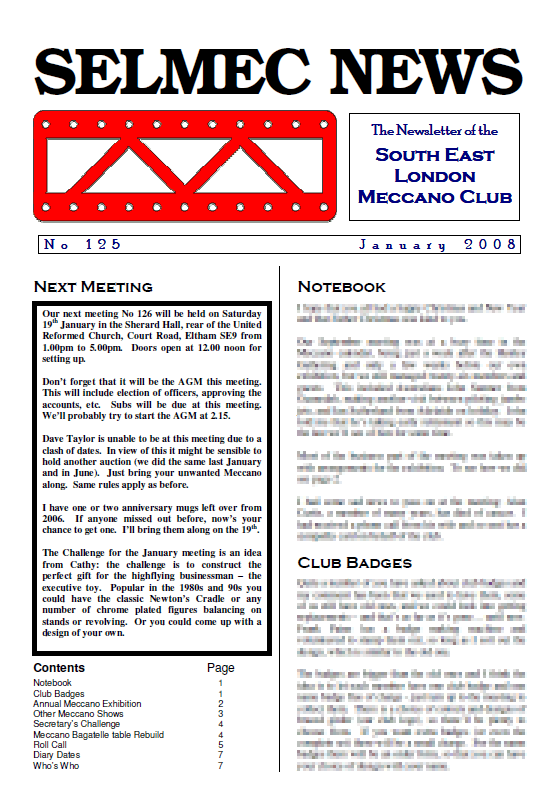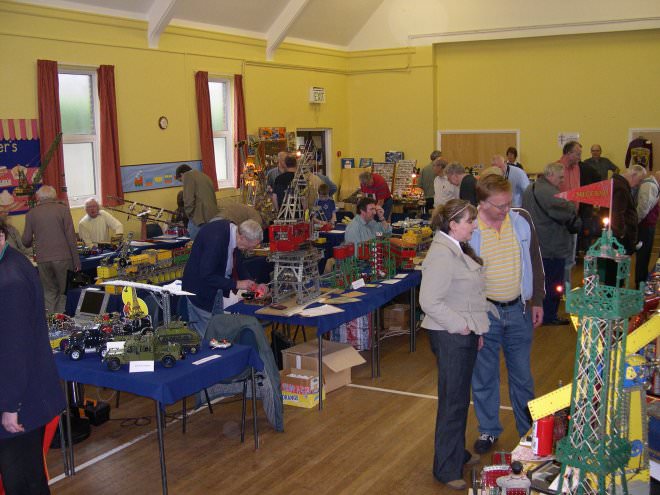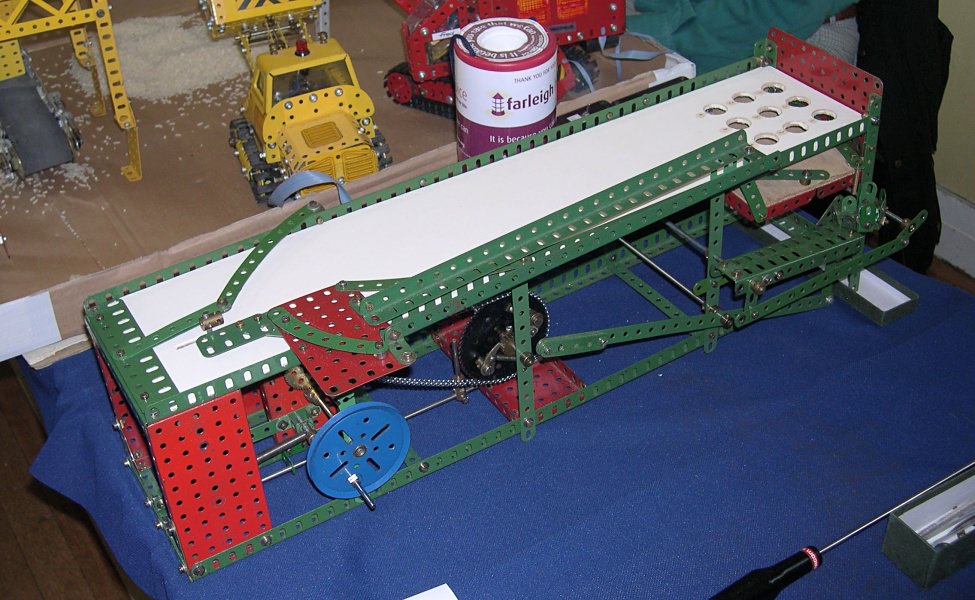January 2008 Newsletter

January 2008 Newsletter
Issue 125
This was one of our informal quarterly meetings where our members showed off their latest Meccano creations.
At around 2:00pm we had a short committee meeting, followed by the Model Tour in which members were invited to give a short talk about their models — in particular their entries for the Secretary’s Challenge!
Report written by Chris Warrell
Our 29th annual exhibition was another successful show, with enough members to easily fill all the available tables. John Gay volunteered to occupy an area in the foyer, even supplying his own table, and guests Eddie Oatley and Ivor Ellard helped swell the numbers.
We had plenty of visitors in the morning, but by mid-afternoon we were in direct competition with an England match in the Euro 2008 qualifying rounds which seemed to completely empty the hall, so the total figure was about 60 adults, 40 OAPs/unaccompanied children and 15 accompanied children (well, we handed out only 15 tickets. I’m sure we had more than 15 children in the hall so it’s possible that some tickets were not handed out).
The refreshments did well again, helped by Cathy and Rose Warrell volunteering to serve all day for the second year running, with help from some of the members on a rota basis. Various goodies were brought by Frank Paine, who was in charge of organising the refreshments, with other members supplying other items of food. Rolls proved very popular because they very quickly ran out.

A general view of the exhibition
The raffle did well again. I think we sold over 100 strips of tickets at £1.00 each again. There were more prizes than last year thanks to various members who supplied Meccano sets and jigsaws etc. Dave Taylor provided a large set in lieu of paying a fee for trading. A lot of the winners had left the hall by the time we drew the tickets so I ended up with around a dozen prizes to dispose of.
Thanks to all the members who turned up with models, and to those who also took a turn with collecting money on the door, helping with the refreshments and selling raffle tickets. Thanks also to Andrew Couzens and Brian Elvidge to tying up posters in the morning before we opened.
No local papers showed, but we did get a photographer from Time Out turn up. This came about through an e-mail I received only a couple of days before the exhibition; they were about to write an article about odd and unusual clubs in London and, obviously, we fitted the bill! (I think Tim Surtell sent them details of the exhibition and maybe that’s how they got on to us). About ten days later the article appeared with the heading ‘The Crazy Gang’. We were top of the list! The article started off like this:
“In London, whether you’re into Meccano or mice, you’ll find folk with similar interests. Peter Watts is your guide to the capital’s weirdest clubs.”
It included this photo and details of the club, the information being taken directly from our website. Other societies featured in the article included the London Didgeridoo Club, North London Society of Model Engineers, Norbury & South London Transport Club and the London Seduction Society. At least it got our name out there — and they didn’t make fun of us, well, not too much! You can read the article on the Time Out website.
Since the exhibition I received three membership applications, one from Allen Berman (of the North East London Meccano Club); another from someone who saw the Time Out article and bought the membership for a friend, Mark Harris, as a gift; and later an application arrived from Michael Allen. We look forward to seeing them at the next meeting.
Models on Display
John Gay — Land Rover police car; Go-cart from 1970s outfit (made by his partner Cathy Claydon); Big wheel; Skip lorry modified and made to work from Modelplan № 107.
Jim Arthur — S-type bus; 1918 fire engine; Two aeroplanes; Mechanical man and trailer; Ferris wheel.
Eric Smith — 1902 Darrancq veteran car; 1914 Dennis Braidwood pump; Medway Queen paddle steamer in blue/yellow parts.
Andrew Couzens —4–6–0 steam locomotive and wagons on Meccano viaduct; Lorry chassis; 20 ton lorry mounted crane based on Dinky toy; Mole from Thunderbirds TV programme.
Brian Leach — Ping pong ball machine.
Jim Ellicott — Covered wagon; Biplane; Olympic Games model; Two kangaroos; Car.
Chris Smith — Models powered by clockwork: Delivery tricycle 1916 manual; Automatic gong circa 1920s № 4 outfit (No. 1 non-reversing motor); Dockside crane (No. 2 motor) and locomotive (Magic motor) from 1937 № 9 outfit; Delivery van (Magic motor) from 1951 № 2 outfit; Land Rover (No. 1 motor, post-war reversing) from the June 1955 issue of Meccano Magazine, № 7 outfit.
Keith Patey — Modified bagatelle game from Geoff Wright’s book of Super Models; Meccanograph based on Andreas Konkoly’s design but with 4-speed gear change.
Ivor Ellard — Builders yard with working models of a dredger, grabbing crane, a bulldozer, a tracked loader and a conveyer belt.
David Smithers — Tower crane incorporating turntable using 2” pulleys and plastic spacers.
Alan Wenbourne — HI (Alpha) Hummer; Rolling bridge; DSG transmission; 6-speed compact gearbox; Six reduction gears; Motorcycle.
Tim Surtell — Teacher and weightlifter; Meccano on the Internet presentation.
Brian Elvidge — № 5 set heavy lorry, motorised with № 1 Clockwork motor; Survivor Car; Avery undertype traction engine of circa 1907 with steering and differential.
Santiago Plicio — The Rotoruator, a large fairground model of his own design with two contra-rotating arms; Small motorcycle with sidecar, rider and pedalling girl.
Geoff Carter — Speedplay robot with programmed sound and movement; Renault F1; Steel Tec Harley Davidson Electra Glide; M&S scooter; Zkwyz Meccanaut little roaming tractor, tumbler and jog dog; Collection Series dump truck; Bernard Périer’s 1/87 scale Boeing Vertol ‘Sea Knight’; Mission the Universe Moon Buggy; Steel Tec Millennium Falcon; USS Enterprise designed by John Lavers.
Eddie Oatley — Hunslet Austerity 0–6–0 saddle tank steam railway locomotive. It is built to 1/17 scale and is an approximate replica of a locomotive manufactured by the Hunslet Engine Co. of Leeds in 1953.
Chris Fry — Piper Cub (From an issue of Constructor Quarterly by Bernard Périer); Triumph TR3A (From issue 77 of Constructor Quarterly by Bernard Périer); Double action ratchet mechanism caterpillar.
Douglas Windibank — Crazy Inventor set walking steam boat and elephant; Three leg table; Racing motor cycle design set 4700; Three-wheeled motorcycle design 3 set 6700; Two cars from new Tuning Series 4951 and 4952; Station tractor; M&S dumper and microlite; № 5 set dragster; Future Master Series excavator; Meccano Combat Set (1978); № 2 French Set.
George Foard — Four powered novelty amusements in a variety of colours: 4-ball helter-skelter; Twin balanced unicyclists; Contra-rotating mobile of eight aircraft; Balanced unicyclist on rotating table.
John Cowdery — Grasshopper-type stationary engine; Contra-rotating fairground ride; ‘The Band’, a skiffle group on stage.
Leslie Maher — Fully remote controlled dockyard crane with grab, approximately 4½ feet high in red/zinc.
Frank Paine — The list passed Frank by, but I know he filled two tables with a vast array of models and sets from different periods in Meccano’s history.
Adrian Ashford — Also not on the list, but I’m pretty sure I saw a Routemaster bus, a locomotive, stationary steam engine and a ball roller.
Chris Warrell — Two space ships: Liberator and Enterprise; Narrow gauge railway; 3-wheel car; Blue/gold car; ‘Pond Life’ model.
Written by Keith Patey
This model is № 9 of Geoff Wright’s Meccano Super Models.
With no marbles to hand (rumour has it that I lost mine years ago!) the first step was to locate some of those small round objects of which I had many when I was a lad (very good memory and imagination, you may surmise!). I drew blanks (also incredulous stares) from assistants in local toy shops who seemed to treat my request with good humour but produced no round objects. The grandchildren will let me have some of theirs, surely. They were having none of it, however, and defended their stock of ‘Kerplunk’ ammunition with surprising tenacity. My pleas proved less than persuasive and no amount of bribery or subterfuge yielded anything. A saviour was close at hand in the shape of the Wife’s sewing-box. She discovered two of these priceless objects among the paraphernalia contained therein.

Bagatelle table
All was now ready for building. The departures from the original were as follows:
- The length was extended to 24½”. This obviated the necessity to join girders thus giving a neater appearance.
- 5½” x 2½” flanged plates were used in place of 5½” strips to re-enforce the lower corners.
- A 3½” pulley, with threaded pin, replaced the two-crank combination handle from which power can be derived.
- Reduction gearing was mounted within the framework (not outside) and utilised one of Nick Rudoe’s ¼" face, 57-tooth gear wheels.
- The 2” sprocket wheel was replaced with the 3” version, which was fitted with a free-wheel device. This meant that the mechanism could only be activated by turning the handle clockwise. Rotation in the opposite direction had a tendency to snag the horizontal rods by pulling, rather than pushing, against the vertical rod in the firing sequence. Over-enthusiastic operation, under this method, could place undue strain on the small sprocket wheel with the possibility of loosening its boss.
- A bracing 5½” x 2½” flanged plate has been located at approximately midway along the base and also provided a bearing for the 11½” rod of the firing mechanism. In the original, this rod did not have a bearing at its far end which could have resulted in undue pressure on the “floating” rod causing it to distort slightly.
- Four 6½” strips served to join and brace the top and bottom girders.
- 7½” girders replace the 5½” version in the original making the two flat trunnions redundant.
- The collecting plate, beneath the large holes has been re-enforced with a small piece of plywood. The smaller marbles had a tendency to “stick” in the holes of the 5½” x 2½” flanged plates without this. A girder and perforated strips have been used as a substitute for one of the large curved strips.
- The table is a piece of hardwood, cut to size and painted with some old stock (from an old D. I. Y. remnant) found in out-of-the-way cupboard, and drilled with nine holes replacing the six in the original. The holes were then given a score-value with some small Letraset transfers and coated with varnish.
- Slight modifications were required to feed the small marble towards the smaller firing pin.
There is no real skill involved in operating this game as the firing mechanism is rather set in its ways. There does, nevertheless, seem to be some play-value, if the level of interest shown by the visitors to the exhibition on 13th October 2007 is anything to go by.
Watch our video of this model